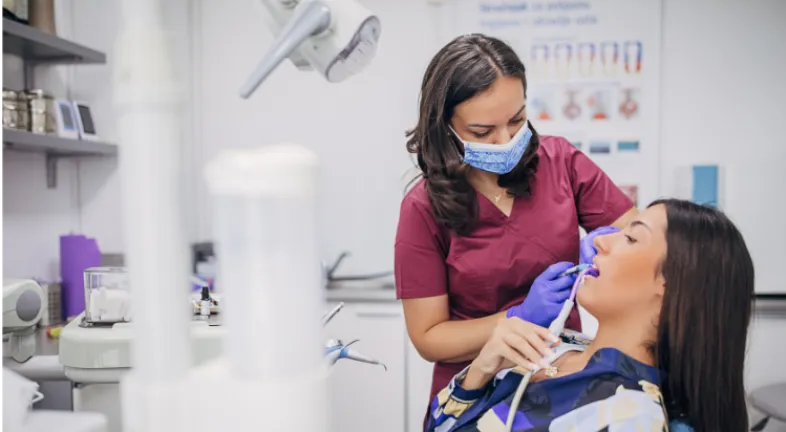
When people talk about removable braces, they immediately think of clear aligners. Yet, several removable dental devices straighten teeth and correct alignment issues.
But are they as effective as traditional wire braces? How does the cost compare? How do they work?
Read on to find out some of the types of removable braces, the types of dental conditions and complaints they address, and what to expect.
Understanding removable braces
Simply put, removable braces are dental devices that people can insert and remove themselves. Generally, patients need to wear them for most of the day but can take them out for teeth cleaning, eating, and drinking.
Most are the contemporary clear aligner style, virtually invisible plastic trays worn on the upper and lower teeth. They have been on the market for about 25 years but have become more popular over the past decade.
Some people mistakenly think that orthodontic options only include removable clear aligners or fixed braces. However, some lesser-known options may also be considered, such as headgear, twin blocks, and other dental plate-style devices. The latter two, in particular, are almost a hybrid between clear aligners and traditional braces in that they use plastic, metal, and wiring, so they aren’t as discrete. However, they can still be removed for eating, drinking, oral hygiene, or when participating in sports activities.
Removable braces: clear aligners
Sometimes these are better known by brand names, but the most popular type of removable braces are clear aligners. Also known as invisible braces, these have become preferred because, unlike traditional braces, they can be removed and are virtually undetectable.
Clear aligners can be used to correct a range of oral and dental conditions but aren’t suitable for everyone. In addition to being less effective on particularly complex conditions, patient compliance to wear the device for 20-22 hours a day is key to treatment effectiveness.
Generally, treatment takes around eighteen months, but some people experience significantly shorter treatment times, with some patients needing to wear their clear aligners for just four to six months.
Removable Braces: Twin Block devices
Twin blocks are commonly used in early intervention orthodontic treatment. Made with a combination of metal and plastic, these are plates that clip onto the upper and lower teeth to help move the jaw into the desired place, expand the room in the mouth for teeth to grow, and more.
Sometimes the twin block is all that is required, but often there will be further orthodontics needed. For example, a patient may be required to wear a twin block device for 12-18 months and then move on to another form of traditional or removable braces for further teeth straightening treatment. The benefit of dual treatment is that there is usually a reduced need for things like surgery beforehand, and it may also give the patient more choices for which kind of orthodontic treatment suits them.
Removable Braces – Headgear
Headgear is used to correct excessive jaw misalignment and tooth overcrowding in children and is only effective when the child’s jaw is still developing. As the name suggests, it consists of a thin framework worn outside of the mouth on the head. It works by exerting sustained forces on the upper and lower jaw, just like conventional braces, to improve the appearance of a child’s smile. Treatment usually means that the child will avoid the need for necessary jaw surgery in later life.
Headgear typically needs to be worn for between 1-2 years and can remain in place when brushing teeth but should be removed when eating or drinking. The device is typically worn for around 12 hours a day, so some children may need to wear it during school hours. This can be challenging for some kids who may feel embarrassed by their appearance. However, like clear aligner treatment, compliance is vital.
Removable braces: When might you choose them?
In some cases, a dentist or orthodontist will advise that traditional treatment like metal braces is the only option available. Many patients are free to choose the option that best suits their budget, lifestyle, and oral health goals.
Some important things to consider when it comes to choosing removable braces include:
Removable Braces: What’s the cost?
Pricing information varies when trying to work out what orthodontic treatment may charge. This is partly because it is such an individualised treatment but also because there are pricing differences between brands.
For example, someone undergoing a big-name clear aligner treatment via their dentist’s clinic may spend over £5000 – though the average is around £4000 according to Dentally. Twin Blocks are also around £999; however, additional treatment costs may need to be factored in.
The average cost for metal braces is £2000 – £3000, but it can be considerably higher depending on the individual’s own orthodontic needs. In some cases, it may be possible to receive braces treatment at a much-reduced rate on the NHS; however, this is typically reserved for children under 18 or adults with exceptional circumstances.
Because there are considerable cost and lifestyle benefits to choosing removable braces, it’s no wonder they continue to be the preferred way for people to undertake teeth straightening treatment.
Curated the best for your knowledge
.webp) Tooth Resorption: Causes, Symptoms, and Treatment Options
Tooth Resorption: Causes, Symptoms, and Treatment OptionsTooth resorption often goes unnoticed until real damage appears. Many people discover it during a routine dental visit and feel a wave of fear, wondering how such a hidden process could silently weaken their smile. The truth is that tooth resorption is more common than most expect, and early detection can make all the difference. By understanding why it happens, how it progresses, and which treatments actually work, you can protect your teeth with confidence. You don’t have to feel overwhelmed. When you know what to look for, you stay one step ahead and safeguard your long-term oral health.
Read More Teeth Troubles Explained: Causes, Symptoms & Fixes
Teeth Troubles Explained: Causes, Symptoms & Fixes Teeth problems happen when we take our pearly whites for granted. When our smile is nice and healthy, we don’t think much about it. And the moment things go south, we panic. Saving, or remaking, that smile becomes a priority. For some, though, the issues are present right from the start. Misalignment, bite issues, and teeth troubles that are more “structural” in nature. They don’t happen due to neglect; rather, they are given by luck, God, nature, whatever you believe in. That being said, no matter the type of tooth trouble, there’s a solution out there. And we’re exploring all that today, teeth diseases and treatment, one by one.
Read More Odontomas: What They Are and How They're Treated
Odontomas: What They Are and How They're TreatedSome dental conditions are quiet. Too quiet, in fact. Odontomas fall into that category. They rarely make noise, yet they change things beneath the surface. And people usually have no idea about them. While malocclusions, teeth shifting, discoloration, or other cosmetic dental issues are fairly well known, odontomas are not. So, an odontoma is technically a type of tooth tumor. It’s benign, harmless, but oddly structured. Hence, it can interfere with tooth eruption, displace teeth, or cause swelling. However, there’s more to it. Here’s a deeper dive.
Read MoreQuick Links

Heading